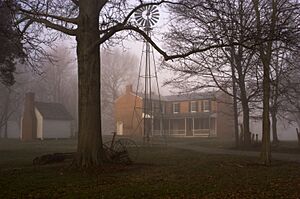Riverside, The Farnsley–Moremen Landing facts for kids
Quick facts for kids |
|
|
Farnsley–Moremen House
|
|

Farnsley–Moremen house
|
|
| Location | 7410 Moorman Road Louisville, Kentucky 40272 |
|---|---|
| Area | 5 acres (2.0 ha) |
| Built | c. 1838 |
| NRHP reference No. | 79003117 |
| Added to NRHP | April 20, 1979 |
Riverside, The Farnsley–Moremen Landing is a special historic farm and house in Louisville, Kentucky. It sits right by the Ohio River and covers about 300 acres. The main house is made of red brick and has two stories, built in a style called Greek Revival. It's known as an "I-house" because of its shape.
This important house was added to the National Register of Historic Places in 1979. This list helps protect places that are important to American history.
Today, there's a visitors center on the property. It has a place for talks, museum displays about the history of the house, and a gift shop.
Contents
The History of Farnsley–Moremen Landing
Early Days and the Moremen Family
The Farnsley–Moremen House has a long and interesting past. The Farnsley family owned the property first. After Mr. Farnsley passed away in 1849, his family had some disagreements about who would own the land. After about twelve years, in 1862, the successful Moremen family bought the property.
Alanson and Rachel Moremen were very good farmers. They made the farm much bigger, growing it to about 1,500 acres. This made it one of the largest working farms in Jefferson County for many decades.
A Busy River Hub
From around 1862 to 1900, the farm was a busy place for river travel. It had a special landing where riverboats could stop. People traveling on the river would come ashore to trade goods, get wood to fuel their boats, or simply rest. The Moremen family even nicknamed their landing "Soap Landing" because they sold homemade lye soap and other farm products there.
A ferry also operated from the landing, carrying people and goods back and forth across the river to Indiana. The Moremens would build large rafts called float barges. They would load these barges with farm products and animals and float them all the way down the river to New Orleans. After selling everything, they would hide their earnings in their clothes, buy horses, and ride all the way back home.
One famous visitor was Henry Clay, a well-known politician. He once rode a float barge from the landing while campaigning for Abraham Lincoln to become president. During his long speeches at every stop, the weather turned very cold. The barge got stuck in the ice, and they had to unload and sell all their goods right there.
Challenges and Restoration
Like many buildings along the Ohio River, the Farnsley–Moremen House was damaged by a huge flood in 1937. This event, known as the Ohio River flood of 1937, caused a lot of trouble. Later, the county built a wall to protect against future floods, but this left part of the historic farm outside the wall, losing its rich topsoil. This made the future of the farm uncertain for the family.
The Moremen family continued to manage the property until 1988. At that time, they sold it to Jefferson County so it could be restored and preserved. On October 10, 1993, the beautifully restored house was opened to the public, allowing everyone to learn about its history.
Other Historic Places to Explore


